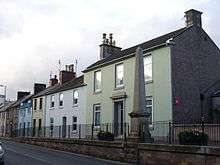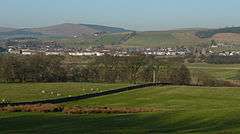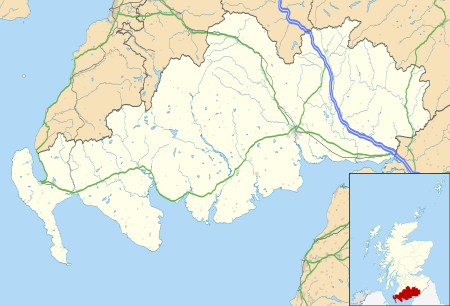Sanquhar
Coordinates: 55°22′05″N 3°55′29″W / 55.36793°N 3.92463°W
Sanquhar /ˈsæŋkər/ (Scots: Sanchar,[2] Scottish Gaelic: Seanchair)[3] is a town on the River Nith in Dumfries and Galloway, Scotland. It lies north of Thornhill and west of Moffat. It is a former Royal Burgh.
Sanquhar is notable for its tiny post office (established in 1712), claimed to be the oldest working post office in the world.[4][5] It was also the place where the Covenanters, who opposed episcopalisation of the church, signed the Sanquhar Declaration renouncing their allegiance to the King, an event commemorated by a monument in the main street. The church of St. Brides contains a memorial to James Crichton, a 16th-century polymath. The ruins of Sanquhar Castle stand nearby. Nithsdale Wanderers, the local team, were formed in 1897. In 1924–25, Wanderers won the Scottish Division Three.
History
The name "Sanquhar" comes from the Scottish Gaelic language Seann Cathair, meaning "old fort". There is a 15th Century castle ruin that overlooks the town, but the name predates even this ancient fort. The antiquary, William Forbes Skene even considered it the probable location of the settlement named Corda in Ptolemy's Geographia. With its location along the River Nith, Sanquhar has been a major crossroads for centuries. Artifacts have been found here from Neolithic times. The remains of several prehistoric British forts can be found in the area as well as traces of a Roman outpost.
The ancient hill fort at Tynron Doon is located about 28 kilometres away from the town. This fort is described in Archaeology of late Celtic Britain and Ireland by L R Laing (1975) as "a well-preserved multivallate hillfort" which probably began its existence in the Iron Age and continued to be used throughout the Dark Ages and into the early Medieval period. During Roman times the fort would have been in Selgovae territory; after the Romans departed it lay on the borders of the Strathclyde Britons and the Galwyddel. This place is associated with a local legend of a "heidless horseman" who is supposed to have ridden down from it as an omen of death, a story which possibly has some origin in a Celtic head cult. The Poetical Works of Sir Walter Scott (1822) attest that Robert the Bruce hid in the forests about this hill after he had killed one of his rivals, John "the Red" Comyn.
In the 9th and 10th centuries, waves of Gaelic settlers came to the area from Ireland. These Scoto-Irish people replaced the native Britons and became the dominant inhabitants for hundreds of years. In the 12th century, Norman colonization of the British Islands brought a feudal system of government and squabbling barons and sheriffs ruled the land for several centuries. Sanquhar is in the county of Dumfriesshire, which rests along the English border. These border counties were constantly in a state of turmoil as groups raided each other across the dividing lines.
During the war of Scottish Independence the English army took over the old castle at Sanquhar. The Lord of the Castle, Sir William the Hardy, Lord of Douglas, learned of this and came up with a clever plot where one man sneaked into the castle and threw open the gates, allowing Lord Douglas to seize it. The English began a counter-attack, but William Wallace learned of the battle and came to the rescue. As the English army retreated, Wallace chased them down and killed 500 of them. Wallace visited the castle on several occasions.
Crichton family
It is believed the Crichton family came to Britain from Hungary. During the reign of Robert the Bruce they obtained the lands round about Sanquhar and ruled over the area from the mid-14th until the mid-17th centuries. Mary, Queen of Scots, (cousin of Queen Elizabeth the 1st) came to Sanquhar in May 1568 after her defeat at the battle of Langside. Lord Crichton of Sanquhar was loyal to Mary, and harboured her until she escaped across the River Nith. For this, he was punished after the Scots lairds besieged and captured Sanquhar castle once again.
The end of the Crichton family power in the area was the result of a lavish party. In July 1617, the King of Great Britain, James VI and I, travelled through Scotland to Glasgow, and on his way home stopped at the castle in Sanquhar. The Crichtons welcomed him with a display so huge that it bankrupted them. It is said that Lord Crichton escorted the king to bed carrying a lighted torch made from £30,000 in bond notes that the king owed Lord Crichton. By 1639, the Crichtons had moved to Ayrshire, and sold their holdings in Sanquhar to the Earl of Queensberry.
A joke in the region is that many a young woman who worked for the Crichtons would "Go in the servants' entrance and come out the family way". However, one well-regarded member of Crichton family was James Crichton (known as 'The Admirable Crichton').
Religious upheaval
A new period of disruption came in the form of religious rebellion. The Covenanters were dedicated Scottish Presbyterians devoted to maintaining Presbyterianism as the sole form of church organisation in Scotland. They led Scotland into England’s civil wars of the period against King Charles I (and later against Cromwell). Throughout the 17th century, there was fighting and persecution by both sides.

Sanquhar was a hotbed of unrest during the Covenanting period. With its position as the only major town in a large area, and situated by the River Nith, it seemed that whenever any remarkable political movement was going on people would go to Sanquhar to proclaim their testimonies on the subject. It was here, in 1680, that Richard Cameron, with a band of armed supporters, posted on the town cross the first declaration of Sanquhar renouncing allegiance to Charles II. The year 1685 saw the second declaration, by James Renwick, who also took a large armed party into Sanquhar, frightening all the townspeople who thought a battle was coming. The Sanquhar Declarations, as they are known, set forth the basis of religious freedom in Scotland. Sanquhar’s location also led those who were hunted and persecuted to pass through or hide in the area.
In the Victorian period the town's mercat cross was transformed into a monument bearing the inscription: In commemoration of the two famous Sanquhar Declarations, which were published on this spot, where stood the ancient Cross of the Burgh; the one by the Rev. Richard Cameron, on 22 June 1680; the other by the Rev. James Renwick, on 25 May 1685, the killing time. If you would know the nature of their crime/Then read the story of that killing time. 1864
The end of the Covenanting period in the early 18th century was not the last religious upheaval for the area. The Church of Scotland was torn by several disputes over the years. One of the major issues was whether the local populations or church headquarters could hire local ministers. In the 1830s many churches seceded and in 1843 a large number of churches broke away to form the Free Church of Scotland. The time was known as the “Great Disruption”. In Sanquhar the minister was leaning towards the new splinter groups, mostly at the urging of his wife. When she died he lost his nerve. The split came and he stayed behind, along with most of his parishioners. He kept his job and his church house, but lost the respect of the community. The creation of the Free Church in Sanquhar, and the wobbling of this minister, left many hard feelings in the town. There was hardly a family that wasn’t torn apart by the disputes. At this point the parish records become a shambles, and hardly a birth or marriage was recorded until civil registration started in 1855.
Sanquhar was legally recognized by the crown as early as the 15th century and was made a royal burgh in 1598. Despite the political unrest in the area agriculture began to flourish in the early 18th century. Local industries came into their own, particularly coal mining. Coal had been dug in the area for hundreds of years, but more advanced methods helped the industry grow. Other industries that depended on coal, such as weaving, carpet making and forges began to appear.
Robert Burns
In the 1780s, the legendary Scottish poet Robert Burns was a frequent visitor to Sanquhar. When he was renovating a farm in 1788, he often passed through on the way back to his wife, Jean, in Ayrshire. Afterwards, he became a well-known face because of his excise duties. Burns called the town "Black Joan" in his ballad "Five Carlins" in which he represented the local burghs as characters. He would stay overnight at the Queensberry Arms in the High Street, making friends with the owner and calling it "the only tolerable Inn in the place".
Wool trade
The wool trade had been an important one in the coastal trading towns of Dumfriesshire and Kirkcudbright since medieval times and by the 18th century Sanquhar had developed as an inland market centre. The Sanquhar Wool Fair, held in July, regulated the prices for the whole south of Scotland. A distinctive two-coloured pattern of knitting which is widely known as 'Sanquhar knitting' takes its name from this small parish. A traveller’s account early in the 18th century tells us: 'Gloves they make better and cheaper than in England, for they send great quantities thither.' Many a poor farm family supported themselves with extra income from these sought-after knitted garments. While knitting died out as an industry, the presentation of traditional Sanquhar gloves is an important part of local celebrations even today. During the 18th century the life of a weaver was enviable. They earned good wages and worked at their looms indoors, often at their homes. They could work whatever hours they wanted, and could take time off in autumn to help farmers with their harvests. It was said that any time there was a noise in the streets all the weavers would be the first ones to drop their work, run out and begin gossiping about the matter. Towards the end of the 18th century, however, advances in technology made the home shops less profitable, and many of Sanquhar’s weavers found themselves looking for other work.
Crawick Village
Other work came in the form of a carpet factory, along the Crawick Water. At first, it consisted of a few separate looms, but by the 1830s, there was a large factory, boasting 54 looms at its height. The carpets made here were world-renowned for their durability and orders came from as far away as South America. A large proportion of their total production was shipped to Valparaíso, Chile.
The location along the Crawick River was also the home of John Rigg’s forge. In the late 18th century, he had been persuaded to move here from Dalston in Cumbria to supply tools for the coalfields. He made a damhead opposite the village of Crawick and used the water to power his factory. The water separated the parishes of Sanquhar and Kirkconnel, and although the forge was on the Kirkconnel side, Sanquhar always laid claim to it. The forge produced shovels and other tools into the 20th century.
The village of Crawick had once been known as a haven for witches. One story is that the parish minister’s cows began making milk that would not churn. He sent one of his servants to tie a branch from a rowan tree over the doorway of the witch’s house in Crawick, which ended the curse. For a long time, a large rowan tree flourished in the front yard of the church, perhaps partly to keep these evil spirits away. Life in Crawick was described beautifully by James Brown, in his History of Sanquhar:
“Crawick Mill was a clean tidy little hamlet pleasantly embosomed on the banks of the Crawick and sheltered from almost every wind that blew, and there was no happier colony of weavers to be found in any country district in Scotland. They were almost all natives, whose whole life associations were connected with the place. We have no pleasanter memory than that of the weavers playing quoits, of which they were very fond, on the summer evenings on the "Alley", a long strip of ground on the banks of the stream behind the Village, while their wives, with their clean "mutches" sat about or sauntered up and down chatting and gossiping, and the bairns were either scrambling along the wooded banks of the Crawick or "paidling" in its clear water, the pleasant babble of the stream as it rushed over the dam-head mingling with the voices of the men at their game and the joyous shouts and laughter of the children.”
Between 1885 and 1916, Crawick even had its own post office (known as Crawick Bridge); it also had gas-powered streetlights two years before the rest of the town of Sanquhar. All of this came to a sad end when one of the owners of the factory died, and the others squabbled. By 1860, the factory was shut down. Many of the weavers moved to larger cities to keep their trade. The forge, and the nearby colliery, kept people employed until the 20th century. During the period just before World War II many people moved away, and the little hamlet was all but deserted. Only a few homes stand there now, the occupants little aware of the industries that once thrived there.
Sanquhar more recently
Sanquhar itself prospered through the late 19th and early 20th centuries. The decline of traditional industries in the middle of this century hurt the town, but now new manufacturers are moving in and there is a strong sense of community in the burgh. Sanquhar had a public school as early as 1793. William Adam, a famous Scottish architect, designed the tollbooth in the centre of town, which is the only surviving building of this type designed by him. Built in 1731, much of the building materials for it were taken from the old castle in Sanquhar and it is currently used as the town museum, containing local artifacts and memorabilia. In 1800, the population of Sanquhar was 2,350. It grew to 3,268 by the year 1830, but by 1991 had collapsed again to 2,910. Today it stands at about 2,100.
The sport of curling runs in the blood of people from Sanquhar. The town has the world’s oldest curling society, formed in 1774 with sixty members. James Brown, who wrote an important history of the town, is also credited with writing the rules universally used for the sport. The witches of Crawick were known for casting hexes on other teams. There were tournaments where the prize was a sack of grain. The winning team would get the food and distribute it to the poor and needy in their hometown.
In the arts, the Sanquhar Pantomime Group performs a traditional Christmas pantomime in aid of local charities. An annual occurrence during the 1990s, it now alternates with a production by the local primary School.
Every year, on the Saturday closest to 18 August, the Royal Burgh of Sanquhar holds its annual Riding of the Marches. This week-long event celebrates the Royal Burgh, through the selection of a "Queen" and her "Attendants" from fourth-year girls in the secondary school, and a parade of lorries and horses, to name but a few events. Many of the pubs are busy during this time, indeed it's been noted that some publicans begin to have delusions of grandeur during this period.
The railway line has remained open for freight and passenger traffic, however the station was closed and only re-opened in recent years.
Neighbouring hills
Sanquhar sits in Nithsdale in close proximity to ranges of interesting hills on either side, the Carsphairn and Scaur range to the west and the Lowther hills to the south east. These hills offer excellent possibilities for the outdoor enthusiast. The Southern Upland Way passes through the town on its way from Portpatrick on Scotland's west coast to Cockburnspath on the east.
See also
| Wikimedia Commons has media related to Sanquhar. |
References
- ↑ "Ainmean-Àite na h-Alba ~ Gaelic Place-Names of Scotland". Gaelicplacenames.org. Retrieved 2015-03-27.
- ↑ "List of railway station names in English, Scots and Gaelic – NewsNetScotland". Newsnetscotland.com. 2011-08-19. Retrieved 2011-10-31.
- ↑ "Ainmean-Àite na h-Alba ~ Gaelic Place-Names of Scotland". Gaelicplacenames.org. Retrieved 2015-03-27.
- ↑ McCarty, Denise (18 April 2014). "World's oldest post office, founded in 1712, offered for sale". Linn's Stamp News. Retrieved 19 April 2014.
- ↑ "Guinness World Records 2014". Guinness World Records. Retrieved 10 August 2015.
- Tom Wilson, Memorials of Sanquhar Kirkyard (pub Robert G. Mann, "Courier and Herald" Press. Sanquhar: J.M. Lang, 1912).
- Sherry Irvine, Your Scottish Ancestry (pub Ancestry Incorporated, 1997)
- James Brown, The History of Sanquhar (pub Dumfriesshire: J. Anderson & Son, Edinburgh and Glasgow: John Menzies & Co., 1891)
- "A History of Sanquhar Knitting", October 1999.
- Dumfriesshire & Galloway Council, Sanquhar, The Historic Walk (pub Upper Nithsdale Community Initiative Ltd., 1998)
- Dumfriesshire and Galloway Libraries, Information and Archives, Through the Lens, Glimpses of Old Sanquhar, Wanlockhead and District, (pub Dumfriesshire and Galloway Council, 1998)
- Bob McGavin & Duncan Close, Old Sanquhar (pub Stenlake Publishing, Ochiltree Sawmill, The Lade, 1998)
- Sanquhar is also the name given to a walking are in the royal burugh of [Forres].
External links
- A photo walk around Sanquhar
- Sanquhar monument
- The Sanquhar knitting patterns
- video and commentary on the Gateside colliery bings.
- video and commentary on the Crawick Multiverse.

